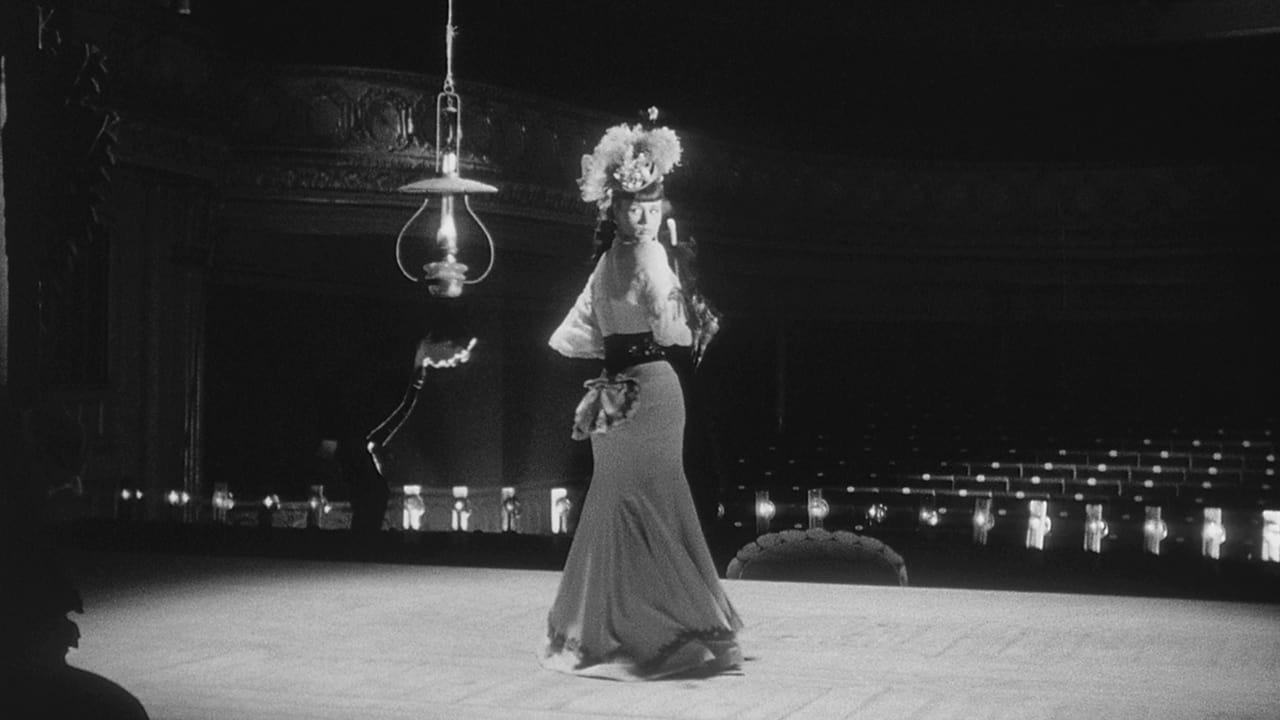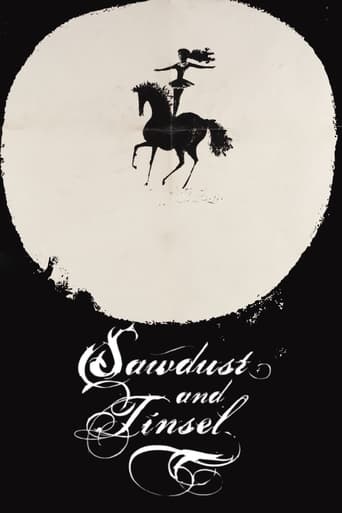

Too much of everything
... View MoreLet's be realistic.
... View MoreYes, absolutely, there is fun to be had, as well as many, many things to go boom, all amid an atmospheric urban jungle.
... View MoreGreat movie. Not sure what people expected but I found it highly entertaining.
... View MoreThe film I selected to watch second during #SeptemBergman was Sawdust and Tinsel. Just as Summer with Monika, Sawdust and Tinsel was released in 1953, and was the second Ingmar Bergman film Woody Allen was exposed to, so I've taken the lead from him as far as beginning this project. I did not enjoy Sawdust and Tinsel nearly as much as Woody Allen did. This is going to be an entry in Ingmar Bergman's filmography that I appreciate, rather than enjoy. On an overcast and grim morning, the circus rolls into the town where the ringmaster's family lives. The ringmaster, Albert Johansson (Åke Grönberg) hasn't seen his wife or two sons in three years. Albert gives off the impression that he loves the nomadic life the circus offers whereas his wife, who hated that life, decided to stay behind and establish roots. Albert has since taken a mistress, Anne (Harriet Andersson) who is desperately against the idea of Albert visiting his estranged wife and sons, as she believes he will use the reunion as a way of getting out of the circus. Jealous, hurt, and looking for a way out, Anne visits another traveling group in the same town and is seduced by an actor who promises her a rich life because he is in possession of an expensive necklace. While Albert visits his wife and learns he is not welcome to return to his family, Anne finds out the necklace is worthless. Both are stuck in the same position as when the audience first meets them, broken and dejected, stuck with the circus and with each other.Several times in Sawdust and Tinsel, Bergman uses silent film techniques which so alter the tone of the film, I struggled to get back into the narrative each time we returned to the plot advancement. Typically, I enjoy methods like this, but they didn't work in Sawdust and Tinsel. The circus metaphor--where the emotions and deepest feelings of human beings are revealed was striking. Bergman's camera got increasingly closer to each subject as more of their desires were exposed. The film is a tough watch, full of humiliation and despair where we continue to see characters humiliated and broken in a worse manner than the previous character was humiliated and broken. The symbolism was nice, and Bergman, being the talented director he was, layers the film in subtlety never losing faith in his audience.
... View MoreAnother one of Ingmar Bergman's best films, this one involves a shoddy, flea-bitten circus early in the 20th Century. Ake Gronberg is the ringleader and Harriet Andersson his young, beautiful second wife. The failing circus arrives in the town where Gronberg left his first wife, who has since become a successful shop owner, and two sons. While he's away visiting them, Andersson, who (rightly) believes he is trying to dump her for a comfortable home life, sneaks off to the local theater, hoping she can hook up with an actor and leave the circus herself. This film is a constant stream of humiliation - but, as cruel as it gets, it never feels like Bergman is mocking these characters. They are quite likable, as pathetic as they are, and you suffer along with them. It's pretty much a perfect film. Shot for shot, I am in awe of it. And each performance is one for the ages. Anders Ek in particular is memorable as a rubber-faced, alcoholic clown. A flashback near the beginning of the film where he humiliates himself to protect his wife from the leering of soldiers (which she gladly invites) is one of the most gruelling sequences in the cinema - and yet it's only the beginning.
... View MoreThanks to Criterion Collection for making a sparkling fresh print of this film available on DVD. Sven Nykvist's cinematography is seen as excellent as ever, especially those brooding cloudy skies. The story moves along nicely, and Bergman's women are clearly their own people (most of the time anyway). The tawdry lives of circus folk is a film cliché, but the characters do live and breathe in this movie rather more completely than we could have hoped. Special attention should be paid to the music of Swedish Modernist composer Karl-Birger Blomdahl. Those punching dissonant chords at the beginning of the film are not unlike much of his music for the outer-space opera he wrote, "Aniara." There is a recording of that work, but it's hard to come by. But you can try to find his Symphony No. 3, "Facetter", and you'll be delighted by how it grows on you. Nevertheless, Bergman pretty much left Blomdahl behind in his subsequent work, and you can see why: Much of it doesn't really fit, which is something you can say about a lot of famous composers who try their hand at film music.
... View MoreSawdust and Tinsel- or The Swedish Master, or The Naked Night, take your pick on a title- is about a man who can't stand himself in his profession, but loves it so much at the same time: the low-brow sensibility of it, the wildness, the freedom to cut it loose with drink or with mad gimmicks during a show, and abandon of the rules when confronted with the law. But he also has a love whom he has his problems with, and her with him as well, leading to an infidelity drama that plays out harshly. Ingmar Bergman said this was a personal film for him, in a big sense, because of the connection to the excitement of the profession being played out against personal turmoil and trouble in professional terms (Bergman even said it was easier for a scrawny director to have a "fat actor" play the part of Arthur). It was reviled by critics and a box-office flop- one of the more expensive films, relatively to others, Bergman made up to that point.It's a film that, seen years later now through the prism of Bergman as one of the world's true artists in the profession, also is deceptively high-brow about the world of low-brow, where experimentation filters in early on and Bergman makes one of his more distinctive marks as a director more-so than a screenwriter (usually, however much Bergman is always an absorbing and challenging director of scenes, writes like no other). The opening scenes, with the story of the sad/pathetic clown Frost (could be a distraction if overdone, but it's an interesting side-not throughout the film as a reminder of true melancholy), are shot like some crazy silent movie, where all we hear are sounds of laughter and little sound effects, brightly lit, shot and composed like some manic tale of desperation and defeat and humiliation, stylized so highly one might think a mad German too control of the reins and made it his own. It's not something all of Bergman's fans will like, but it shows him, even in 1953, trying new things, letting himself be free with the material as he sees fit.Then, after this, we get into the "typical" Bergmania; a sort of square-block played out between Arthur, who is meeting his ex-wife in the town he's at for the circus performance (the actress playing his wife, I forget her name, is brilliant at displaying just enough pragmatism to show her as the most sane of anyone in the film), and Arthur's current beau Anne is somewhat attracted to a sneaky actor named Frans, who plays a wicked game of arm wrestling and leading to a somewhat Albert and Anne, and how this casts a dark shadow on the rest of the proceedings- including through the circus performance, which becomes a daring act of do by Bergman where he makes things effective once squaring in on the 'duel' between Arthur and Frans. For those that love Bergman doing relationship drama, this is solid, if not exceptional, stuff on display. And the ending, truth be told, might just be one of the most engrossing, and completely bleak (if you could imagine that Bergmanites) that he ever made (who doesn't cry with the scene with the bear?) It might sound like Bergman has made a depressing little tome on circus life, the sorrows of living with the filth and lice and reckless frivolity of life as vagabond entertainers. But it's also a lot of fun, as the low-brow material displays another side to Bergman, which is something close to weird, comic excess. Sometimes Bergman even mocks his own world; a scene with Albert asking Gunnar Bjornstrand's theater director (the latter always shown in low-angle, a smart choice) makes the theater come off satirically compared to Bergman's more serious treatments of the profession in his films. And, seriously, where else will we get a dwarf tossing in a work by this filmmaker? And meanwhile, he also has a great turn from his would-be Emil Jannings in Åke Grönberg, who is big and over-emotional and strung-out on his excesses of anger and resentment, mostly with himself (watch for that gun!) And Andersson, of course, is ravishing as she was- if not erotically as such- in Monika, filmed the same year.Now finally available just a bit easier than previously thanks to Criterion, Sawdust and Tinsel is a fine spectacle of a director branching out stylistically (if not to the spectacular Felliniesque aspirations it might have as a pre La Strada or The Clowns), while keeping his feet tethered to his personal cinema. Not quite in my top 10 of Bergman's, but considering how many great films he made it's close.
... View More